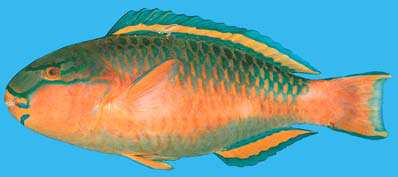| SCARIDAE |

Chlorurus capistratoides, 24.0 cm SL
(photo by Ukkrit Satapoomin)
|
Chlorurus capistratoides (Bleeker, 1847) Palecheek Parrotfish |
|
D IX, 10; A III, 9; P1 14-15; GR 49-61. Head bluntly rounded anteriorly. Teeth fused to form dental plates; dental plates relatively smooth (covered with cement), and broadly exposed; 1-3 canine teeth on side at rear of upper dental plates; 2 rows of scales on cheek; median predorsal scales 4 (rarely 3); caudal fin of initial phase slightly rounded, of terminal phase truncate to slightly emarginate. Color: initial phase reddish brown with a brownish orange bar on each scale anteriorly, the bars becoming shorter posteriorly, and forming spots on caudal peduncle and base of caudal fin; 4 pale pinkish bars on body; rear half of caudal peduncle and caudal fin whitish, suffused with pale salmon-pink; dorsal fin dull orange with a bluish grey margin and median longitudinal band; anal fin brown with a bluish grey cast; pectoral fins yellow becoming brown basally. Terminal phase blue-green, shading to pale salmon ventrally; a salmon-pink bar on each body scale, the bars becoming oval spots on caudal peduncle and base of caudal fin; head blue-green dorsally with narrow blue-green bands; cheek below horizontal blue-green band pale salmon-pink; dorsal and anal fins salmon with broad bright blue borders and a narrow bright blue band at base; caudal fin salmon with bluegreen upper and lower borders and a broad crescentic light blue posterior border. Size: maximum length about 31 cm. Distribution: Indian Ocean. Remarks: found on coral and rocky reefs at depths of 2-20 m. |
|
|